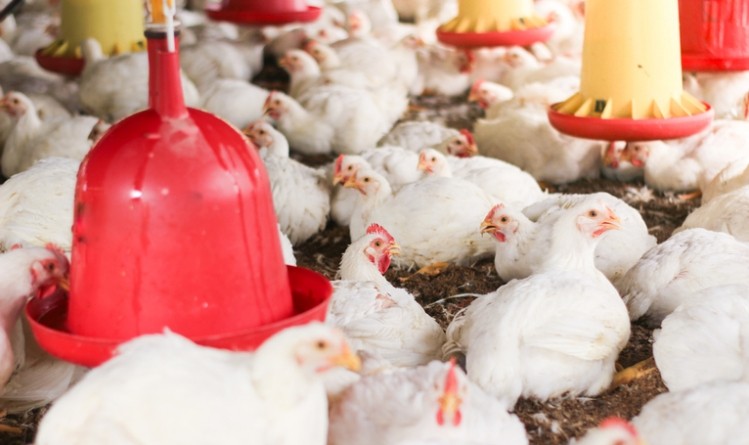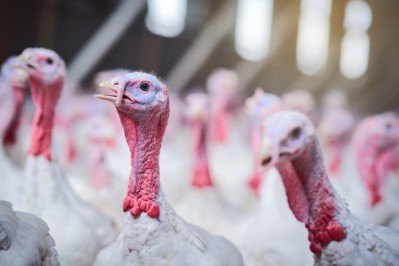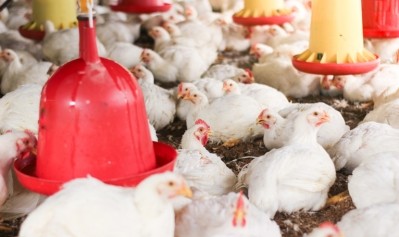Orange corn diets might reduce incidence of footpad dermatitis in broilers

Footpad dermatitis (FPD), damage and inflammation of the plantar surface of the foot, is of concern for poultry because FPD affects the birds' welfare and production value.
Footpad dermatitis is painful and causes costly chicken paw downgrades, carcass condemnations, and reduced live weights, said the researchers, writing in Poultry Science.
“The damage to the birds' feet causes alterations in gait and is associated with decreased body weight (BW) gain and reduced feed intake resulting from pain (Haslam et al., 2007; Shepherd and Fairchild, 2010; Da Costa et al., 2014).”
The importance of footpad scoring is evidenced by its presence in many welfare audits in the US and Europe, they said.
Research by Jong et al. (2014) found the largest contributing factor or cause of FPD to be the presence of wet litter.
Preventatives for FPD must have practical routes of administration, so feed and water additives have commonly been tested. Previously tested dietary preventatives include vitamins: biotin, riboflavin, pantothenic acid, minerals, amino acids: methionine and cystine, feed-grade enzymes, electrolytes (Na, K), and microelements (Zn) (Shepherd and Fairchild, 2010; Swiatkiewicz et al., 2017).
“Despite the many additives or products tried, a definitive solution to prevent FPD in broilers has yet to be identified,” noted the team.
Carotenoid quantity
The hypothesis for this study, involving US researchers from a number of universities as well as ag bioscience company, NutraMaize, was that diets containing orange corn, when compared with diets containing yellow or white corn, would reduce the severity of FPD in broiler chickens on wet litter.
When compared with yellow and white corn, orange corn contains higher quantities of carotenoids, antioxidant pigments, believed to play a role in skin and feather health, they said.
Methodology
To assess the use of supplemental carotenoids from non-GMO orange corn to prevent or reduce FPD, the authors included a wet litter challenge.
The idea was to evaluate orange corn's possible protective effects on broiler chicken feet, and to evaluate carotenoid deposition via altered pigmentation of the liver and fat pad, reported the authors.
Cecal microbiome analysis was completed to evaluate differences between wet and dry litter as well as among three corn types, they said.
Female Ross 708 chickens (40 birds per pen) were placed in 3.71 m2 pens on wood shavings at a stocking density of 0.08 m2/bird at 1 d of age and followed up through 42 days of age, outlined the animal scientists.
The birds were raised on one of two litter treatments, dry or wet litter, and fed one of three diets: 1) orange, 2) yellow, or 3) white corn.
Each diet × litter treatment combination was replicated four times with one empty pen between each of the experimental pens, they continued.
All pens began the study with fresh pine wood shavings litter. The wet litter was achieved by wetting the litter by hose once per week to reach at least 60% moisture content, added the team.
The researchers used Global Animal Partnership guidelines (GAP guidelines [2017]) to determine the incidence of FPD. Footpad scores of 1 and 2 correlate with mild to severe lesions, ulceration, dark papillae, or bumblefoot, while a score of 0 represents minimal or healed damage.
Key findings
The results of this research found that the orange corn diets were associated with lower severity of FPD (fewer scores of 1 and 2) especially during the latter half of this study.
“After 27 days of age, the incidence of moderate footpad scores decreased for birds fed orange corn but increased for birds fed yellow or white corn.
“Birds fed orange corn never developed scores greater than 0 on the control litter. This study found that feeding orange corn diets can reduce the severity of FPD in broiler flocks, exposed to both wet and dry litter conditions.”
Given the diet caused only minimal changes to the gut microbiome, the authors said the beneficial effects of corn carotenoid concentration is not likely mediated via changes to the gut microbiome but rather more likely through localization of carotenoids throughout the body and at the site of insult.
An unexpected benefit of the orange corn diet was that it increased the birds' average BW throughout this study. This concurred with the results of a previous study of broilers fed yellow corn supplemented with vitamin A in which the birds had increased BW from 14 days of age until conclusion of the study (Pretorius and Schönfeldt, 2013), they reported.
In addition to improving the weight gain of the birds in this study, the researchers observed that the orange corn diets were associated with increased pigment deposition in the liver and fat pad.
Source: Poultry Science
DOI: https://doi.org/10.1016/j.psj.2021.101054
Title: Orange corn diets associated with lower severity of footpad dermatitis in broilers
Authors: D M Karcher et al















